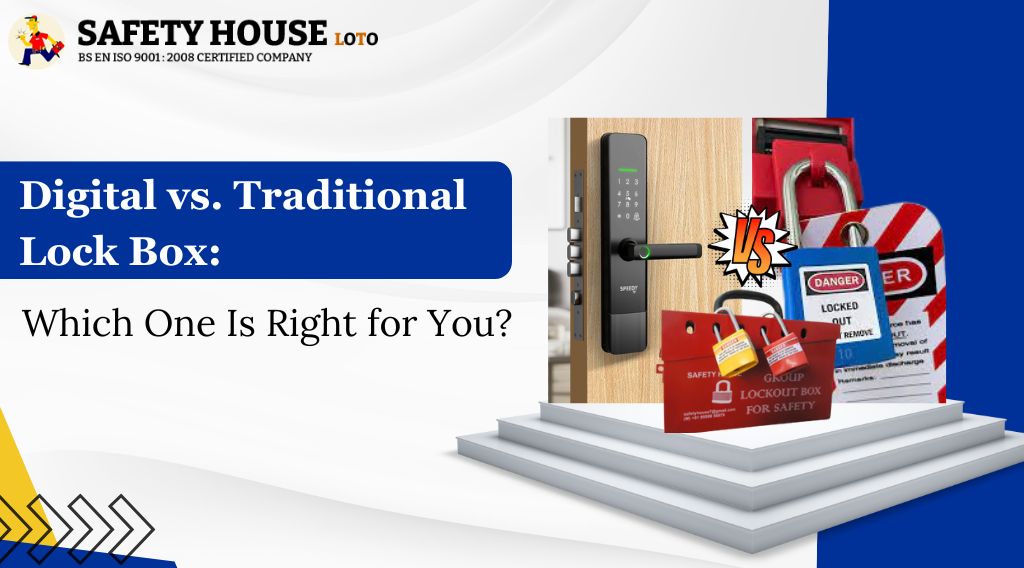
Digital vs. Traditional Lock Boxes: Which One Is Right for You?
In industrial safety protocols, particularly within Lockout/Tagout (LOTO) procedures, selecting the appropriate lock box is crucial for ensuring the safety of personnel and equipment. Lock boxes, including Group Lockout Boxes and key boxes, are essential tools that facilitate the secure management of keys during maintenance and servicing activities. With advancements in technology, digital lock boxes have emerged as alternatives to traditional mechanical ones. This article explores the differences between digital and traditional lock box to help you determine which is best suited for your needs.
Understanding Lock Boxes in LOTO
A lock box is a secure container used to store keys that control access to energy-isolating devices. In a Group Lockout scenario, a Group Lockout Box allows multiple workers to apply their personal locks, ensuring that equipment cannot be re-energized until all locks are removed. This system enhances safety by requiring each authorized employee to verify that the equipment remains de-energized during maintenance.
Traditional Lock Boxes
Advantages:
- Simplicity and Reliability: Traditional lock boxes are mechanical devices with no electronic components, making them straightforward to use and less prone to technical failures.
- Cost-Effective: Generally, they have a lower upfront cost compared to digital alternatives.
- No Power Dependency: They do not require batteries or electrical power, ensuring functionality even during power outages
Disadvantages:
- Limited Access Control: Managing access requires physical keys, which can be lost, duplicated, or stolen, posing security risks.
- No Audit Trail: Traditional lock box do not provide records of access, making it difficult to track who accessed the keys and when.
- Manual Key Management: Assigning and retrieving keys is a manual process, which can be time-consuming and error-prone.
Digital Lock Boxes
Advantages:
- Enhanced Security Features: Digital lock box often include features such as PIN codes, biometric access, and RFID card readers, reducing the risk of unauthorized access.
- Audit Trails: They can record access logs, providing a history of who accessed the box and when, which is valuable for compliance and accountability.
- Remote Access and Management: Some models allow administrators to manage access permissions remotely, facilitating quicker response times and flexibility.
- Customizable Access Levels: Access can be tailored for different users, with options for temporary or scheduled access, enhancing operational efficiency.
Disadvantages:
- Higher Initial Investment: Digital lock box typically have a higher purchase price and may incur additional costs for software or network integration.
- Power and Connectivity Requirements: They rely on batteries or electrical power and may require network connectivity, which can be a limitation in certain environments.
- Technical Complexity: Installation and maintenance may require technical expertise, and there is a potential risk of electronic malfunctions.
Choosing the Right Lock Box for Your Needs
When deciding between a digital and traditional lock box, consider the following factors:
- Operational Environment: In environments where power supply and network connectivity are reliable, digital lock box can offer enhanced features. In contrast, traditional lock boxes are suitable for locations where simplicity and independence from power sources are priorities.
- Security Requirements: If detailed access records and customizable permissions are essential, digital lock boxes provide superior capabilities. For basic security needs, traditional lock boxes may suffice.
- Budget Constraints: Evaluate the total cost of ownership, including initial investment and ongoing maintenance. While digital lock boxes have higher upfront costs, they may offer long-term savings through improved efficiency and security.
- Compliance and Accountability: Industries with strict regulatory requirements may benefit from the audit trails and access controls provided by digital lock boxes.
Conclusion
Both digital and traditional lock boxes play vital roles in ensuring safety during maintenance and servicing operations. Traditional lock boxes offer simplicity and reliability, making them suitable for straightforward applications. Digital lock boxes provide advanced features that enhance security, accountability, and operational efficiency. Assessing your specific needs, operational environment, and regulatory requirements will guide you in selecting the most appropriate lock box solution for your organization.
At Safety House Loto, we offer a comprehensive range of lockout solutions. Our products are crafted to ensure maximum safety and compliance, providing you with the tools necessary to maintain a secure working environment.
